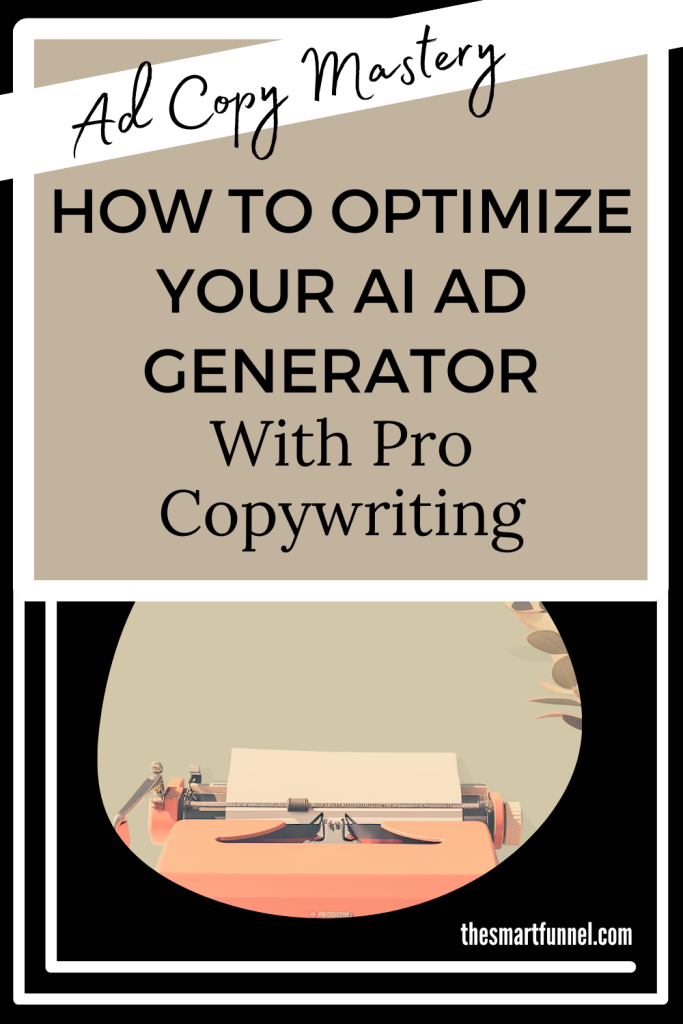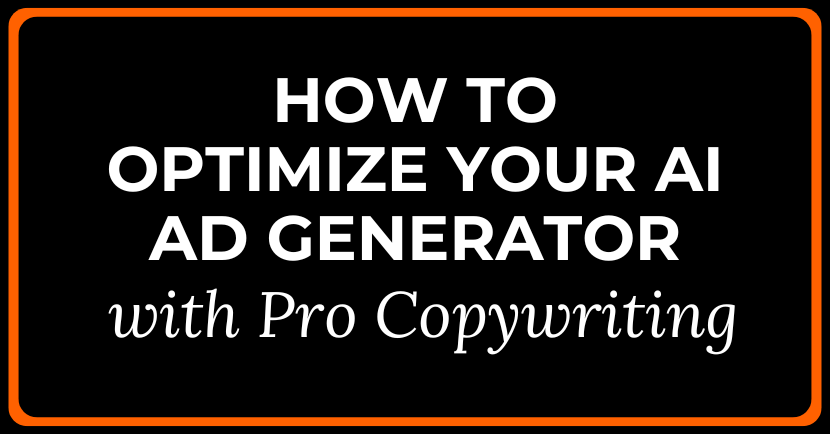If you’re a small business owner, it’s hard to look at current tech trends and know which way the wind is blowing. After all, you have enough on your plate. But what’s often useful is to look at what the big industry players are doing. And if you look at AI (artificial intelligence) and big consultancy firms like McKinsey, you’ll see something interesting happening. It’s creating a boom. According to the NYT, 40% of McKinsey’s revenue last year was AI-related.
Yes, AI is here to stay, and it’s time to embrace it. But how? Do you use it to write your blog posts or create your websites? What about running ads? The last question got us interested in a bit of a debate, so we decided to explore it further. Are AI generators worth it? How can you use them in conjunction with copywriting to protect your brand voice and brand identity? Read on for our thoughts on how small business owners can get this working for them.

What Is an AI Ad Generator?
AI is still a relatively new field, so you’re forgiven if you haven’t heard the term. Who knows if the phrase will even exist a few years from now in this fast-paced environment? The best way to think of an AI ad generator is a bit like a digital assistant offering copywriting services. AI tools can whip up ad content fast. Some also offer AI-generated images for a campaign, so it’s a powerful tool. You can use a free tool like the free version of ChatGPT, though you’ll find most AI platforms now come with a premium version which you need if you are using it in a business capacity.
They create digital ads by sifting through millions of bits of data, learning about trends and content styles, and churning out ad copy for pretty much any niche you can imagine, either for text ads or the script for video ads. So they are going on what’s worked before and aiming to emulate that. You can see how useful this is when you’re swamped and need a new AD launched ASAP. But there is a drawback. These ad tools aren’t foolproof. And since they model themselves on what’s gone before, you aren’t likely to get anything truly groundbreaking – and originality matters in advertising. They’re a tool, not a replacement, for using a unique brand voice in your advertising.
The Limitations of Using an AI Ad Copy Generator
AI ad generators seem appealing. They can save the day when you need to get things moving in your business fast. Nevertheless, they have limitations, and it’s important to understand what they are.
The main issue is their reliance on past data for their learning. Data is instrumental sometimes. You can make predictions by looking at past trends to help determine the future. It’s critical in any business. But it’s a tricky thing in advertising.
Modeling best practices on past trends can create something of a cookie-cutter approach to advertising. It’s advertising that ticks many boxes, but it won’t dazzle as it lacks that magic ingredient: originality. And we’re in an era where most industries are fiercely competitive, which means even the tiniest differentiator is vital.
And therein lies the risk of AI.
You end up with an ad that blends into the background, indistinguishable from a thousand others. And that also makes it harder to connect with your target audience and potential customers, impacting brand awareness and brand loyalty. That is the point where you’ll start to see your ad costs spike because indistinguishable ads equate to lower engagement rates and a lower conversion rate.
You end up spending more on ads than you budgeted for, wiping out any savings you made when you used an AI ad generator in the first place. So, it’s important to remember that advertising is more than just reaching your target audience with a professional ad design.
At its heart, advertising is about connecting with people, having a voice and message that resonates enough and draws enough emotion for someone to want to take action. You’re communicating with humans, which sometimes means using a human to communicate.
The Art of Professional Copywriting
The most stunning examples of professional ad copy look more like art than business writing. Here are a few famous ones:
- Tesla: It takes 3.1 seconds to read this ad. The same time it takes a Model S to go from 0 to 60 mph
- Emirates: Earth is 71% water. We cover the rest.
- Uber Pool: Two’s company. Three’s even cheaper.
Professional copywriters can add a human touch to the writing that an algorithm might miss. They can add emotion and tap into the emotional needs of an audience.
That ability to connect is more than wordplay. You need to understand some of the subtleties of human psychology, cultural differences, and your brand’s personality. Plus, a professional copywriter knows how to adapt. They have a skill for getting quick feedback and understanding what tweaks are needed to tailor the copy.
That’s creative flair and emotional intelligence, which is hard for AI to replicate.
Professional Copywriting + AI: the Perfect Duo?
This article might seem biased so far towards professional copywriting. That’s someone true because there are distinct advantages to it. However, there are also benefits to using AI. So here’s another idea: why not combine the two for better results?
Combining the two approaches can help you realize the strengths of both. Use the power of AI for what it’s best at – combing vast quantities of data, spotting trends, and generating ideas. That gives you a solid foundation that will open up some avenues in your advertising you may not have considered until this point.
Once you have that, blend it with a professional touch. Adding human insight, emotional intelligence, and creativity of a professional copywriter is the perfect way to smooth out the rough edges of an AI-produced ad, polishing it until it gleams. It’s a synergy that will help you produce an AI of higher quality.
And here’s the kicker: since AI is so fast at creating stuff, once you have a baseline, professionally polished copy, you can use AI to produce slight variations. If you’ve done PPC advertising before, such as using the Facebook ads manager or Google ads campaigns, you’ll know that launching different creatives is critical in that initial testing stage of your ad and marketing campaigns.
Producing AI + Human Ad Copy: Step by Step Ad Creation Process
If you are ready to try a combination of AI and professional copywriting, here is what you need to do. We’ve broken this down step by step, but it’s a really simple process.
Step 1: Create a Basic Draft Using an AI Ad Generator
Start by using AI to do your brainstorming and spit out some new ideas. AI works best when you have clear instructions, so don’t skip your own research. If you are planning to advertise, you should already have a clear idea of your target customer, the message you want to convey, and the benefits of what you are selling. Give that information to AI so it can do a better job of producing a result.
Step 2: Initial Human Review
If you have experience with ad copywriting, you can do this step yourself. If you lack experience, use a professional copywriter (like our team at the Smart Funnel.) A professional copywriter will assess each draft for tone of voice and style and compare it against your brand voice. They’ll use it as a starting point to produce some alternatives that have more of a human touch and added emotion.
Step 3: Added Creative Input
You can make this an iterative process between three parties: your audience, the generative AI, and the copywriter. After your professional copywriter has made some tweaks, start testing your ad. You need at least two different ads to compare and see which produces the highest conversion.
If you aren’t getting enough data, tweak your campaign settings to reach a wider audience. While you are doing that, keep the copy iterations going. Give AI your professionally-drafted copy, ask AI to offer some tweaks, and use that as your next baseline. Get your copywriter to tweak it and test it on your audience as another ad variant.
Step 4: Monitor Your Conversion Rates
There are no limits to how many iterations you can produce and add to your ad campaign. However, you probably have a limited test budget. So, monitor the metrics of your ads to see which copy produces the best engagement rates. Remember to focus on conversions, not clicks. If you don’t have an extensive budget, test via social media campaigns too, using your existing following and various social media posts.
You can also limit your efforts to one ad platform, like Facebook, to help focus your metrics. That way, you only have to tweak your Facebook ad copy before resting instead of changing it across multiple platforms.
Some Top Tips
If you are going to invest in this dual approach to produce ads, there are a few helpful tips to get the most out of the process. Here they are:
Tip 1: Be clear about your processes. Understand what the copywriter will do and what you’ll lean on for AI. Don’t mix the two.
Tip 2: Aim for seamless collaboration. Create a workflow that allows you to bounce copy quickly between the writer and AI to find the best tone. Otherwise, you’ll experience delays, which could be a massive problem if you already have an ad campaign up and running.
Tip 3: Use a copywriter with experience in AI. They need to understand how to use AI, how to detect that writing style, and how to make AI-written copy more human-like.
Tip 4: Keep tabs on the latest trends. This industry is changing incredibly fast, and you need to stay in the loop. Get on X (Twitter) and follow AI experts so you know what’s going on in the industry and can discover different platforms which may work better for you.
Tip 5: Train your AI for your advertising campaigns. Don’t expect an AI to have a magic wand. AI platforms rely on good human input. Train it with instructions on what you want. Be specific.
Tip 6: Give your copywriters creative freedom. If they offer you ad copy that’s a bit quirky or a far cry from the original AI version, you might feel nervous about using it in an ad. Remember, the best ads all come down to effective testing. So try it out (as long as it doesn’t hurt or damage your brand voice—a professional copywriter should never do that, anyway). You can always change it later.
Tip 7: Always use A/B testing. Various social media platforms and ad platofmrs allow you to split test ads. Use this to test different versions of your copy. Feedback from your audience is far more valuable than trying to second-guess what they might like.
Tip 8: Encouraging a learning environment. Copywriting isn’t about getting things right or wrong. It’s like putting paint on a canvas. You paint layer upon layer until you achieve that final, beautiful picture. That only happens if you embrace mistakes and make them learning opportunities.
Tip 9: Remember that your landing pages are equally important for your ads. Don’t forget about polishing the copy on those, otherwise you face ads that get clicks but no conversions.
Wrapping Up With Some Final Thoughts
Imagine a world where all ads are produced using an AI ad generator. What do you see? I think everyone has a different answer to this question. But it’s worth remembering a core principle that underpins sales throughout the world: humans sell to humans. It’s always been that way, and while AI is an asset, a human knows how to persuade in a way that seems hard for an AI to emulate. Maybe that will change. But for now, it’s worth thinking about how you combine the two. Either way, this article should give you some food for thought.
Pin This Post


